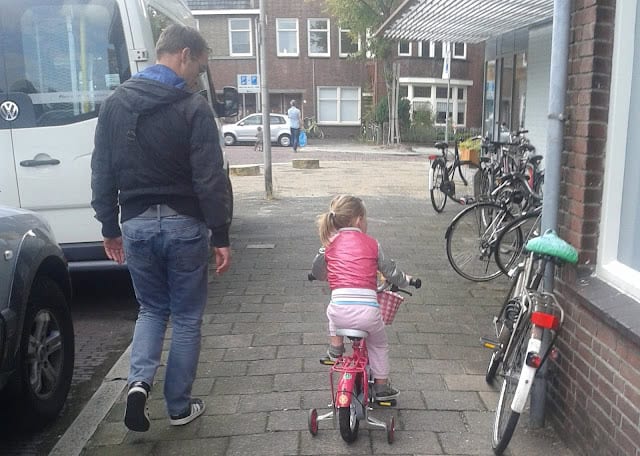
Urban Springtime: My daughter and I
Thank you to Gerben Helleman (The Hague University of Applied Sciences) for providing this post.
This article was originally published in the Urban Springtime.
When my daughter was born eleven years ago, many new worlds opened for me. In addition to the world of diapers and sleepless nights, my use and perception of public space changed. The width of the sidewalk and loose paving stones suddenly became important. First through my walks with the pram and a few years later when my daughter stumbled down the street (on foot or by bicycle). In her early years the walk to the local supermarket was a great adventure, because everything was interesting to her: the flowers from the front gardens, the leaves, the twigs of the trees lying in the street, the chains on the yellow fire hydrants, the baker’s shop window, etc. All things that stood out much more at her eye level and stimulated her senses.
Yet, when we talk about outdoor play in our professional world we often talk about playgrounds with fixed and manufactured play equipment. My daughter taught me that we should look at the bigger picture. We need to be concerned with well-connected walking and cycling routes, clear crossings, landscaping, and clear sightlines. We need to get away from the focus on formal play areas (playgrounds, public sports field, skatepark). Those who want to encourage outdoor play also need to look how children use informal spaces (bushes, streets, lawns, squares).
Take the sidewalk again. At the age of four my daughter ran and jumped from one manhole cover to the other with her friend when we walked home from school. The small ones were ten points and the large ones fifty. From about six years old, my daughter meets her friends on the nearby public sports field to play soccer. After a while, however, the children want to do something else. Then they go to the surrounding bushes to build huts, look for insects or play hide and seek in the area. The mix of informal and formal play offerings matter much.
Outdoor play for children is about much more than the small, predefined target areas that we build for them. As Colin Ward (1978, p.73) explained in The Child in the City, “a city that is really concerned with the needs of its young will make the whole environment accessible to them, because, whether invited to or not, they are going to use the whole environment”. We can facilitate that in simple ways. By placing letters, numbers or colours on the sidewalk. By hanging a chalkboard on a blank wall where children can draw and write. By planting different flowers. By leaving the fallen trees in parks so that you can climb over them. It is the little things in life that matter. Literally and figuratively.
This column appeared in the book ‘Inspirationally-Playful’ edited by Professor John H. McKendrick (2023). It was published by the Child and Adolescent Health Research Group (CAHRG) of the Research Centre for Health (ReaCH) at Glasgow Caledonian University, in association with the International Play Association (IPA). Made available for the 22nd International Play Association Triennal World Conference in Glasgow. The book is a gathering of more then fifty reflections on what has inspired, and continues to inspire, those with a professional interest in play. It is a global collection, comprising thoughts from each of the six main populated continents, with contributions from nineteen different nations.
Gerben Helleman is a Researcher of public space and child-friendly cities in the research group “Healthy Lifestyle in a Supporting Environment” at the Hague University of Applied Sciences in the Netherlands.
Photo by Gerben Helleman.

